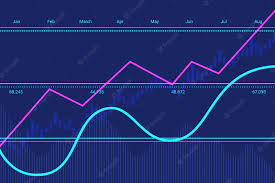Breadth indicators are useful tools for gaining an insight of the market’s underlying strength. If you just look at the prices on the market, you may not always be able to determine the direction that the market is trending in.
Instead of just comprehending the stock market, breadth indicators assist us understand how the “market of stocks” is doing. This is in contrast to understanding the stock market alone.
Divergences are a common way for Breadth indicators to predict a market move before it really takes place. Divergences occur when the markets are making a fresh move but a large number of stocks are not participating in that move.
When doing an analysis of how a trend is moving in the market, traders need to be familiar with the foundations of breadth indicators as well as the 14 most used breadth indicators. In this blog, we will explore these topics.
What exactly are these “Breadth Indicators”?
Breadth indicators provide traders and investors with a means to evaluate the market’s state in its entirety. Utilizing stock indexes allows one to analyse the movement that occurs in the stock market.
For instance, the Nifty 50 Advance/Decline Line is a cumulative reference that helps us understand whether more stocks are growing or decreasing over time. This information may help us make better investment decisions.
Using this computation, we are able to better understand the general feeling of investors about all of the companies that make up the index.
Breadth indicators are mostly used for the following two functions:
Market sentiment: These indications may assist us in assessing whether the current trend of the market will continue or if it will begin to change.
Breadth indicators may also assist us in identifying the strength of a bullish or bearish trend, which is an important part of technical analysis.
The following is a list of the 15 Breadth Indicators that Traders have to be familiar with in order to comprehend the current state of the stock market:
Breadth Line
The breadth line, which is also known as the Advance/Decline line, is one of the finest methods to measure the strength of the market internally. Another name for the breadth line is the advance/decline line.
This line represents the cumulative total of gains after deducting losses. The formula for the same is presented in the following format:
Breadth Line Value equals the difference between the number of stocks that advanced and the number of stocks that declined, plus the previous day’s value for the breadth line.
The breadth line will increase when the number of advancing stocks is greater than the number of declining stocks, and it will fall when the opposite is true.
Negative divergence happens in the stock market when the stock market average is increasing but the breadth line is not rising. This indicates that just a small number of stocks are participating in the advance, and traders should proceed with caution while trading in the index.
The McClellan Oscillator
The McClellan Oscillator is calculated by finding the difference between two exponential moving averages of advance and decrease. The two averages are known as the EMA for 19 days and the EMA for 30 days.
This indicator’s readings, both positive and negative, reflect whether a greater number of stocks are climbing higher or falling down. If the 19-day exponential moving average (EMA) is higher than the 39-day exponential moving average (EMA), then the indication is positive; however, if the 19-day EMA is lower than the 39-day EMA, then the signal is negative.
This indicator tends to go back and forth between the ranges of -100 and -150 or +100 and +150 on a regular basis.
In addition to that, you may use this oscillator to identify divergences, both positive and negative.
The McClellan Ratio-Adjusted Oscillator:
As Mcclellan discovered that the advance and decrease alone may be impacted by the total number of issues traded, he created the Mcclellan Ratio-Adjusted Oscillator as a result of this discovery.
The ratio of net of advances minus decrease, divided by the total number of issues traded, is the formula for calculating the Mcclellan Ratio-Adjusted Oscillator.
The ratio is multiplied by 100 so that it is simpler and more straightforward to understand.
The McClellan Summation Index is the area beneath the Mcclellan Ratio-Adjusted Oscillator. This summation index measures the overall trend of the market.
The McClellan summing up may be interpreted in a number of different ways, and when it is read as +1,000, it is seen as being neutral. The McClellan Summation Index typically remained between 0 and +2,000 points during the 1960s. This was the case despite some minor fluctuations.
The interpretation of this indicator may be thought of as being very similar to that of the Mcclellan Ratio-Adjusted Oscillator.
Breadth Thrust:
A thrust occurs when the departure from the norm is sufficiently substantial to be recognised and when that deviation signifies either the conclusion of an old trend or the beginning of a new trend. In other words, a thrust occurs when an old trend comes to an end or a new trend begins.
Mark Zweig is the one who invented one of the breadth indicators that is used to assess breadth thrust. This indicator generates a 10-day Simple Moving Average of Advances and divides it by the total of Advances and Declines.
The advance-decline ratio is calculated by dividing the total number of shares that have increased in value by the total number of shares that have decreased in value.
The ratio of advances to declines may be calculated for a number of different time periods, including one day, one week, or one month.
This indicator may be used by itself to determine whether or not the market is overbought or oversold at the current time.
One of the most well-known up and down volume indicators is called the ARMS Index. This index is also referred to as TRIN and MKDS.
Up volume refers to the amount of trading that occurs in all advancing stocks, while down volume refers to the volume of trade that occurs in all dropping stocks. This is an additional method for determining the strength of the market.
When there is a significant amount of volume moving in the opposite direction of the market when it is at or near its low point, and when there is a significant amount of volume moving in the opposite direction of the market when it is at or near its high point.
This indicator has a negative correlation with market prices and is computed by dividing Advance/Decline by Up Volume/Down Volume. The result of this calculation is the indicator.
The difference between the number of net new highs and net new lows is a basic breadth indicator that can be determined by subtracting the number of net new lows from the number of net new highs.
The number of equities that have recorded new 52-week lows is referred to as “New lows,” while the number of stocks that have made new 52-week highs is referred to as “New highs.”
This indicator offers some assistance in determining whether the market’s internal strength or weakness is stronger.
When the indicator shows a positive value, it indicates that there are a greater number of new highs. When the indicator is in a bearish state, on the other hand, there are a greater number of new lows.
Number of New Highs Relative to Number of New Lows: This is the simplest indicator available, and it indicates purchasing when the number of new highs on a daily basis is more than the number of new lows.
On the other hand, one should consider selling when there are more daily new lows than there are daily new highs. This is the optimal time to sell.
The Plurality Index The Plurality Index is a statistic that is always positive, and it is determined as the total of the absolute difference between the advances and decreases during a period of 25 trading days.
When the plurality index has high values, it indicates that a bottom and reduced prices are on the horizon. When the plurality index has high values, it indicates that a top is about to form.
Ninety percent of Downside Days:
This indicator is a good tool for determining when the stock market has reached its bottom. It takes into account daily upside and downside volume as well as daily point gains and losses.
On a given day, a day is said to have a 90 percent downside when the percentage of points lost surpasses the total of gained points and lost points, as well as when the percentage of downside volume exceeds the total of upward volume and downward volume by 90 percent.
Absolute Breadth Index:
This is a kind of breadth indicator that is computed by considering the absolute difference between the stocks that are advancing and those that are falling.
In general, the presence of huge numbers implies an increase in volatility, which in turn suggests that there will be major swings in stock prices in the next weeks.
High-Low Logic Index The high-low index is a logic index that compares equities that are achieving their 52-week highs with stocks that are hitting their 52-week lows.
The high-low index is mostly used by traders and investors in order to validate the current market trend of a wide market index.
Ticks Index:
This index is computed by subtracting the total value of all the stocks in the market that have experienced an uptick from the total value of all the stocks that have experienced a downtick. The resulting value is plotted on a chart based on a certain time period.
It is a good tool for spotting inefficiencies in the market, despite the fact that it is an intraday indicator since it uses data on a tick-by-tick basis.
In conclusion, it is important to keep in mind that breadth indicators can only be computed on indexes, not on individual stocks, and that this limitation prevents them from being applied to individual companies.
These indications, when combined with the data that is readily accessible, may be used to do an analysis of the robustness of the stock market.
In order for traders to increase their chances of success, they should make use of market breadth indicators in conjunction with other kinds of technical analysis tools, such as chart patterns and technical indicators.




